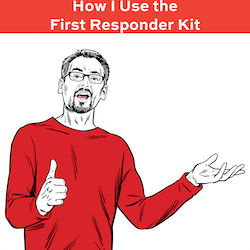If you want to quickly understand the top health and performance issues on your SQL Server, there’s no better, easier, free-er way to do it than the open source First Responder Kit.
When you find a bug or want something changed, read the contributing.md file.

To get the new version:
- Download the updated FirstResponderKit.zip
- Azure Data Studio users with the First Responder Kit extension:
ctrl/command+shift+p, First Responder Kit: Import. - PowerShell users: run Install-DbaFirstResponderKit from dbatools
- Get The Consultant Toolkit to quickly export the First Responder Kit results into an easy-to-share spreadsheet
Consultant Toolkit Changes
- Improvement: on SQL Server 2019, we export a sample query plan for each missing index request. This helps you know the kinds of queries that are triggering missing indexes, and helps you hand-craft an even better index.
That change does mean a new querymanifest.json, but no changes to the spreadsheet. You only need to use the new querymanifest.json if you want that new feature – otherwise, just copy your spreadsheet and querymanifest.json into the new release’s folder. (I’m planning a new first tab for the spreadsheet for next month’s release, so I don’t want you to have to do this work twice if you’ve been doing customizations – next month’s release will be the bigger bang for the buck there.)
sp_Blitz Changes
- Improvement: if you’ve accidentally got “show actual execution plans” turned on while running any of the First Responder Kit scripts, it’s now automatically turned off inside the proc. (#2911, thanks Daniel Hutmacher and Erik Darling.)
- Fix: now skips Instant File Initialization check on Amazon RDS because we can’t run xp_errorlog. (#2879, thanks Ray Rankins.)
- Fix: more Amazon RDS compatibility improvements. (#2888, thanks Ray Rankins.)
- Fix: Agent jobs without failure emails were only showing up in the alerts if they were scheduled. (#2905, thanks Mike Scalise.)
sp_BlitzCache Changes
- Fix: queries with a duration of more than 2,147,483 seconds (that’s 596 hours) would cause an arithmetic overflow. (#2890, thanks Ron MacNeil.)
- Fix: the Multiple Plans warning was only including the number of plans in the top 10 result set, and now instead shows the total number of cached plans for this query altogether. (#2900, thanks Erik Darling.)
- Fix: the Many Duplicate Plans warning math is getting closer to accurate. (#2909, thanks Erik Darling.)
sp_BlitzFirst Changes
- Fix: in the high CPU details in the How to Stop It column, results could be out of order depending on varchar sorting. (#2876 and #2878, thanks Adrian Buckman.)
sp_BlitzIndex Changes
- Improvement: table-level columnstore visualization on partitioned tables now shows the partition boundaries. (#2860, thanks Nick Papatonis.)
- Fix: included columns now show their correct sizes in bytes. (#2880, thanks Scott Holiday.)
- Fix: SQL Server 2019’s new sample query plan for missing indexes is now more likely to produce a query that generated the missing index request. I think there’s still possibility for edge cases here where this is wrong, and the 2019 user base is so small that we don’t have great testing on this yet. (#2883, thanks Greg Dodd and Erik Darling.)
sp_BlitzLock Changes
- Fix: avoid arithmetic overflows in wait time checks. (#2916, thanks Erik Darling.)
sp_BlitzWho Changes
- Fix: last month’s release wouldn’t save output to table on SQL Server 2008 & R2. (#2875, thanks Mike Halford and Vladiir Vissoultchev aka wqweto.)
- Fix: add 1-second lock timeout to avoid blocking on QRY_PROFILE_LIST_MUTEX. (#2907, thanks larkinis.)
- Fix: error due to unclosed quotation mark. (#2914, thanks Igor.)
sp_DatabaseRestore Changes
- Fix: the @StopAt and @OnlyLogsAfter parameters couldn’t be used at the same time. (#2898, thanks Greg Dodds.)
SqlServerVersions.sql Changes
- Fix: the uninstall.sql script now removes this table from any database, not just the current one. (#2893, thanks Andreas Jordan.)
- Fix: updated the latest build numbers. (#2897, thanks Anthony Green.)
For Support
When you have questions about how the tools work, talk with the community in the #FirstResponderKit Slack channel. Be patient: it’s staffed by volunteers with day jobs. If it’s your first time in the community Slack, get started here.
When you find a bug or want something changed, read the contributing.md file.
When you have a question about what the scripts found, first make sure you read the “More Details” URL for any warning you find. We put a lot of work into documentation, and we wouldn’t want someone to yell at you to go read the fine manual. After that, when you’ve still got questions about how something works in SQL Server, post a question at DBA.StackExchange.com and the community (that includes me!) will help. Include exact errors and any applicable screenshots, your SQL Server version number (including the build #), and the version of the tool you’re working with.

